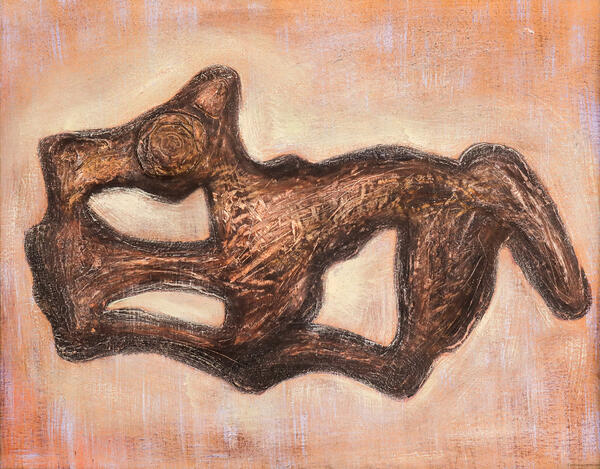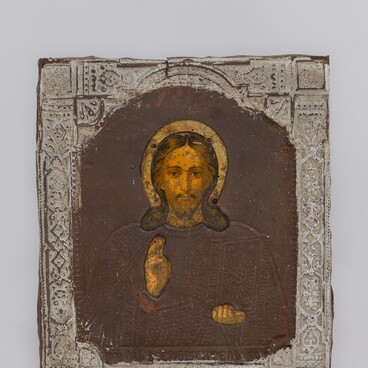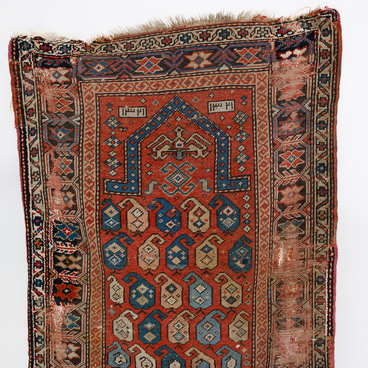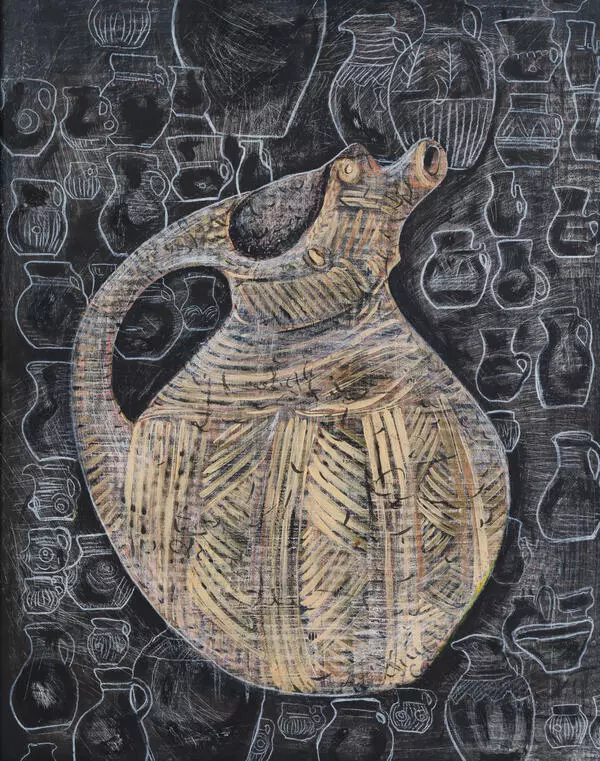The painting “Scythian History” is part of the project “Sloy” (Layer) by the Dagestani artist Patimat Guseinova. The series consists of 24 works depicting archaeological finds discovered on the territory of Dagestan: jugs, fragments of mirrors, buckles, unusual medieval brass and bronze items. According to the artist, her paintings show the rich heritage of her ancestors and echo the atmosphere of bygone times. Patimat Guseinova sought to unravel the symbolism, form and meaning of ancient objects with the help of modern means of fine arts.
The painting “Scythian History” is done in clay-brown hues that convey, in the artist’s words, “the historical dust and the cultural layer of the earth”. In the “Sloy” project, Patimat uses painting to clean the artifacts created by ancient craftsmen and show them to her contemporaries. The painting “Scythian History” depicts a bronze plaque with a zoomorphic image. It was found during archaeological excavations in the Khasavyurt mound. It dates to the 3rd century BC, when the territory of Dagestan was occupied by Scythian tribes.
The Scythians were a nomadic people who inhabited the Black Sea steppes as far as the borders of modern China. Their history is shrouded in legends and myths, as the Scythians had no written language and left no documentary evidence of their civilization. The Scythians are known about from the works by ancient authors — Herodotus, Hippocrates, and Pliny the Elder, as well as from archaeological finds. Most of them belong to the characteristic animal style.
Quivers for arrows, sword handles, women’s necklaces, mirror handles, buckles, bracelets, torcs, combs, plait ornaments — all Scythian household and hunting items could be decorated with animal figures. The animals were always depicted from the side, moving and often struggling with one another, but their heads were always turned to the man. For Scythians, they were the embodiment of totems — the animal ancestors of their kin who guard and bring luck. The animals depicted on the hilt of a sword or quiver of arrows were supposed to help the hunter in strength, agility and courage. The most popular talisman of the Scythian warrior was the wolf — it is depicted in this painting by Patimat Guseinova.
The painting “Scythian History” is done in clay-brown hues that convey, in the artist’s words, “the historical dust and the cultural layer of the earth”. In the “Sloy” project, Patimat uses painting to clean the artifacts created by ancient craftsmen and show them to her contemporaries. The painting “Scythian History” depicts a bronze plaque with a zoomorphic image. It was found during archaeological excavations in the Khasavyurt mound. It dates to the 3rd century BC, when the territory of Dagestan was occupied by Scythian tribes.
The Scythians were a nomadic people who inhabited the Black Sea steppes as far as the borders of modern China. Their history is shrouded in legends and myths, as the Scythians had no written language and left no documentary evidence of their civilization. The Scythians are known about from the works by ancient authors — Herodotus, Hippocrates, and Pliny the Elder, as well as from archaeological finds. Most of them belong to the characteristic animal style.
Quivers for arrows, sword handles, women’s necklaces, mirror handles, buckles, bracelets, torcs, combs, plait ornaments — all Scythian household and hunting items could be decorated with animal figures. The animals were always depicted from the side, moving and often struggling with one another, but their heads were always turned to the man. For Scythians, they were the embodiment of totems — the animal ancestors of their kin who guard and bring luck. The animals depicted on the hilt of a sword or quiver of arrows were supposed to help the hunter in strength, agility and courage. The most popular talisman of the Scythian warrior was the wolf — it is depicted in this painting by Patimat Guseinova.





